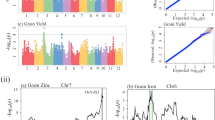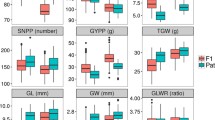Abstract
North Carolina design III (NCIII) is one of the most powerful and widely used mating designs for understanding the genetic basis of heterosis. However, the quantitative trait mapping (QTL) conducted in previous studies with this design was mainly based on analysis of variance (ANOVA), composite interval or multiple interval mapping methods. These methodologies could not investigate all kinds of genetic effects, especially epistatic effects, simultaneously on the whole genome. In this study, with a statistical method for mapping epistatic QTL associated with heterosis using the recombinant inbred line (RIL)-based NCIII design, we conducted QTL mapping for nine agronomic traits of two elite hybrids to characterize the mode of gene action contributing to heterosis on a whole genomewide scale. In total, 23 main-effect QTL (M-QTL) and 23 digenic interactions in IJ (indica ×japonica) hybrids, 11 M-QTL and 82 digenic interactions in II (indica ×indica) hybrid QTLs were identified in the present study. The variation explained by individual M-QTL or interactions ranged from 2.3 to 11.0%. The number of digenic interactions and the total variation explained by interactions of each trait were larger than those of M-QTL. The augmented genetic effect ratio of most M-QTL and digenic interactions in (L 1–L 2) data of two backcross populations (L 1 and L 2) showed complete dominance or overdominance, and in (L 1+L 2) data showed an additive effect. Our results indicated that the dominance, overdominance and epistatic effect were important in conditioning the genetic basis of heterosis of the two elite hybrids. The relative contributions of the genetic components varied with traits and the genetic basis of the two hybrids was different.
Similar content being viewed by others
References
Bruce A. B. 1910 The Mendelian theory of heredity and the augmentation of vigor. Science 32, 627–628.
Chen Z. J. 2013 Genomic and epigenetic insights into the molecular bases of heterosis. Nat. Rev. Genet. 14, 471–482.
Cockerham C. C. and Zeng Z. B. 1996 Design III with marker loci. Genetics 143, 1437–1456.
Comstock R. E. and Robinson H. F. 1952 Estimation of the average dominance of genes. In Heterosis (ed. J. W. Gowen), pp. 494–516. Iowa State College Press, Ames, USA.
Crow J. F. 1948 Alternative hypotheses of hybrid vigor. Genetics 33, 477.
Frascaroli E., Canè M. A., Landi P., Pea G., Gianfranceschi L., Villa M., Morgante M. et al. 2007 Classical genetic and quantitative trait loci analyses of heterosis in a maize hybrid between two elite inbred lines. Genetics 176, 625–644.
Garcia A. A. F., Wang S. C., Melchinger A. E. and Zeng Z. B. 2008 Quantitative trait loci mapping and the genetic basis of heterosis in maize and rice. Genetics 180, 1707–1724.
He X. H. and Zhang Y. M. 2011 A complete solution for dissecting pure main and epistatic effects of QTL in triple testcross design. PLoS One 6, e24575.
He X. H., Hu Z. L. and Zhang Y. M. 2012 Genome-wide mapping of QTL associated with heterosis in the RIL-based NCIII design. Chin. Sci. Bull. 57, 2655–2665.
Jones D. F. 1917 Dominance of linked factors as a means of accounting for heterosis. Genetics 2, 466–479.
Kao C. H. and Zeng Z. B. 2002 Modeling epistasis of quantitative trait loci using Cockerham’s model. Genetics 160, 1243–1261.
Larièpe A., Mangin B., Jasson S., Combes V., Dumas F., Jamin P. et al. 2012 The genetic basis of heterosis: multiparental quantitative trait loci mapping reveals contrasted levels of apparent overdominance among traits of agronomical interest in maize (Zea mays L.) Genetics 190, 795–811.
Li L. Z., Lu K. Y., Chen Z. M., Mu T. M., Hu Z. L. and Li X. Q. 2008 Dominance, overdominance and epistasis condition the heterosis in two heterotic rice hybrids. Genetics 180, 1725–1742.
Li Z. K., Luo L. J., Mei H. W., Wang D. L., Shu Q. Y., Tabien R. et al. 2001 Overdominant epistatic loci are the primary genetic basis of inbreeding depression and heterosis in rice. I. Biomass and grain yield. Genetics 158, 1737–1753.
Luo L. J., Li Z. K., Mei H. W., Shu Q. Y., Tabien R., Zhong D. B. et al. 2001 Overdominant epistatic loci are the primary genetic basis of inbreeding depression and heterosis in rice. II. Grain yield components. Genetics 158, 1755–1771.
Melchinger A. E., Utz H. F., Piepho H. P., Zeng Z. B. and Schön C. C. 2007 The role of epistasis in the manifestation of heterosis: a systems-oriented approach. Genetics 177, 1815–1825.
Melchinger A. E., Utz H. F. and Schön C. C. 2008 Genetic expectations of quantitative trait loci main and interaction effects obtained with the triple testcross design and their relevance for the analysis of heterosis. Genetics 178, 2265–2274.
Riedelsheimer C., Czedik-Eysenberg A., Grieder C., Lisec J., Technow F., Sulpice R. et al. 2012 Genomic and metabolic prediction of complex heterotic traits in hybrid maize. Nat. Genet. 44, 217–220.
Schön C. C., Dhillon B. S., Utz H. F. and Melchinger A. E. 2010 High congruency of QTL positions for heterosis of grain yield in three crosses of maize. Theor. Appl. Genet. 120, 321–332.
Schnable P. K. and Springer N. M. 2013 Progress toward understanding heterosis in crop plants. Annu. Rev. Plant. Biol. 64, 71–88.
Shull G. H. 1908 The composition of a field of maize. Am. Breeders. Assoc. Rep. 4, 296–301.
Stuber C. W., Edwards M. D. and Wendel J. F. 1987 Molecular marker-facilitated investigation of quantitative trait loci in maize. II. Factors influencing yields and its component traits. Crop. Sci. 27, 639–648.
Stuber C. W., Lincoln S. E., Wolff D. W., Helentjaris T. and Lander E. S. 1992 Identification of genetic factors contributing to heterosis in a hybrid from two elite maize inbred lines using molecular markers. Genetics 132, 823–839.
Syed N. H. and Chen Z. J. 2005 Molecular marker genotypes, heterozygosity and genetic interactions explain heterosis in Arabidopsis thaliana. Heredity 94, 295–304.
Wang D. L., Zhu J., Li Z. K. and Paterson A. H. 1999 Mapping QTLs with epistatic effects and QTL × environment interactions by mixed model approaches. Theor. Appl. Genet. 99, 1255–1264.
Xiao J., Li J., Yuan L. and Tanksley S. D. 1995 Dominance is the major genetic basis of heterosis in rice as revealed by QTL analysis using molecular markers. Genetics 140, 745–754.
Xing Y. Z., Tan Y. F., Hua J. P., Sun X. L. and Xu C. G. 2002 Characterization of the main effects, epistatic effects and their environmental interactions of QTLs on the genetic basis of yield traits in rice. Theor. Appl. Genet. 105, 248–257.
Xu S. 2007 An empirical Bayes method for estimating epistatic effects of quantitative trait loci. Biometrics 63, 513–521.
Yu S. B., Li J. X., Xu C. G., Tan Y. F., Gao Y. J., Li X. H. et al. 1997 Importance of epistasis as the genetic basis of heterosis in an elite rice hybrid. Proc. Natl. Acad. Sci. USA 94, 9226–9231.
Zhou G., Chen Y., Yao W., Zhang C. J., Xie W. B., Hua J. P. et al. 2012 Genetic composition of yield heterosis in an elite rice hybrid. Proc. Natl. Acad. Sci. USA 109, 15847–15852.
Acknowledgements
This work was financially supported by the 973 Programme (no. 2011CB100102), the National Natural Science Foundation of China (no. 31000666), the China Postdoctoral Science Foundation (no. 2012M511722, no. 2014T70769), Hunan Province Postdoctoral Science Foundation (no. 2012RS4039) and Hunan Province Natural Science Foundation (13JJ4065).
Author information
Authors and Affiliations
Corresponding author
Additional information
[Li L., He X., Zhang H., Wang Z., Sun C., Mou T., Li X., Zhang Y. and Hu Z. 2015 Genomewide mapping reveals a combination of different genetic effects causing the genetic basis of heterosis in two elite rice hybrids. J. Genet. 94, xx–xx]
Lanzhi Li and Xiaohong He contributed equally to this work.
HZ, ZW and CS participated in programme compile and data analysis. TM and XL conducted the field design and material collection. YZ and ZH conceived of the study, and participated in its design and coordination and helped to draft the manuscript. All authors read and approved the final manuscript.
Rights and permissions
About this article
Cite this article
LI, L., HE, X., ZHANG, H. et al. Genomewide mapping reveals a combination of different genetic effects causing the genetic basis of heterosis in two elite rice hybrids. J Genet 94, 261–270 (2015). https://doi.org/10.1007/s12041-015-0527-8
Received:
Revised:
Accepted:
Published:
Issue Date:
DOI: https://doi.org/10.1007/s12041-015-0527-8




